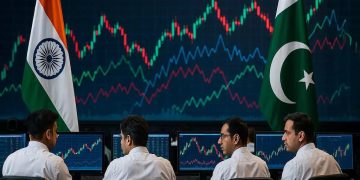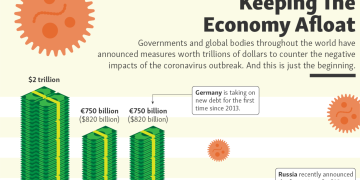How innovation, automation, and AI are reshaping global growth while testing the limits of productivity and policy.
Introduction: Technology as the Economy’s Quiet Engine
In a world where growth forecasts are inching downward — from the International Monetary Fund’s 3.3% in 2024 to a projected 3.2% in 2025 — technology has quietly taken center stage as both savior and disruptor.
While traditional engines of expansion, such as exports and manufacturing, are stalling, the digital economy is accelerating, reshaping industries from finance to logistics, and redefining what “growth” even means in the 21st century.
“Technology is no longer a sector,” said Gita Gopinath, First Deputy Managing Director of the IMF, in a recent address. “It is the infrastructure of the modern economy.”
Across continents, governments and corporations are betting on artificial intelligence, automation, and digital infrastructure to offset the slowdown. Yet the story is not purely optimistic. The global tech surge also brings inequality, regulatory anxiety, and geopolitical friction.
This is the paradox of digital transformation: a force of renewal within an increasingly fragmented global landscape.
1. The Digital Economy’s Expanding Weight
The size of the global digital economy is staggering. According to the OECD’s 2025 Digital Outlook, it now accounts for roughly 17% of global GDP, up from 11% a decade ago.
China, the United States, and the European Union remain the digital powerhouses, but the fastest growth is happening in Southeast Asia, India, and parts of Africa — regions leapfrogging traditional industrialization through mobile-first, AI-driven innovation.
In Malaysia, digital industries contribute nearly 23% of GDP, supported by the government’s MyDIGITAL blueprint and a wave of start-ups in fintech and logistics. India, propelled by its Digital India initiative, added over 400,000 new tech jobs in 2024 alone.
Even in sluggish economies like Germany or Japan, technology investment remains the one bright spot. As OECD economist Laurence Boone notes, “Digital transformation is cushioning the slowdown — it’s the reason global productivity hasn’t fallen faster.”
2. Artificial Intelligence: From Experiment to Infrastructure
No technology embodies this transformation more than artificial intelligence.
Once confined to research labs and speculative conversations, AI now drives practical outcomes: optimizing supply chains, predicting consumer demand, automating document processing, and even designing products.
The IMF’s World Economic Outlook report calls AI “the most consequential general-purpose technology since electricity.”
In the United States, AI investment reached $180 billion in 2024, while China’s national AI strategy continues to drive cross-sector adoption, from healthcare triage systems to smart manufacturing hubs in Guangdong and Zhejiang.
For developing economies, AI offers both hope and hazard.
On one hand, it promises to fill labor shortages and enhance productivity. On the other, it risks amplifying the digital divide — between those who build algorithms and those replaced by them.
According to McKinsey’s 2025 Global AI Readiness Survey, nearly 40% of firms in emerging markets have adopted AI tools in at least one function, compared to 75% in advanced economies. Yet the productivity boost is uneven — concentrated in data-rich sectors like finance, logistics, and consumer tech.
3. Automation and the Reconfiguration of Labor
The automation wave that began in factories is now sweeping through services — from call centers to hospitals.
Goldman Sachs estimates that by 2030, 300 million jobs globally will be affected by automation or AI augmentation. But unlike earlier fears of mass unemployment, the shift today is more complex: it’s a reallocation of work, not a disappearance of it.
In Japan and South Korea, robotics are replacing workers in eldercare and logistics. In the United States, generative AI tools are rewriting marketing copy and legal briefs, while freeing human employees for higher-value tasks.
The European Union, meanwhile, faces a regulatory challenge: balancing innovation with worker protection under the EU AI Act.
The new reality is a hybrid one — where human creativity and algorithmic efficiency coexist uneasily.
As the World Economic Forum noted in its Future of Jobs Report 2025:
“Automation will not eliminate work; it will redefine it. The winners will be societies that retrain, not retreat.”
4. The Geopolitics of Digital Power
Behind the optimism lies a deeper struggle: digital transformation has become the new terrain of global competition.
The United States leads in AI research and semiconductor design, while China dominates in manufacturing and data scale. The European Union, though technologically sophisticated, struggles to forge digital sovereignty between these two giants.
Trade restrictions on chips, software, and data flow are now the frontlines of a new kind of economic war.
The U.S. Commerce Department’s continued restrictions on advanced semiconductor exports to China have rippled through global supply chains, affecting not just Chinese firms but also American and Taiwanese suppliers.
In response, nations are racing to secure their digital independence.
India launched its National Semiconductor Mission to attract chipmakers. The EU announced a €43 billion Chips Act to strengthen local manufacturing.
Even smaller economies — from Vietnam to the UAE — are crafting national data strategies to capture a slice of the digital pie.
Yet experts warn that fragmentation could undermine innovation. “If data becomes trapped within borders,” says Professor Erik Brynjolfsson of Stanford, “we risk losing the very network effects that make digital economies thrive.”

5. The Productivity Puzzle
For all the hype, the productivity gains from digital transformation remain elusive at the macro level.
Despite a surge in tech investment, global productivity growth has stagnated at around 1.5% per year — far below the digital era’s early promises.
Why? Economists cite three reasons:
- Lag in diffusion — new technologies take time to spread across firms and industries.
- Skills mismatch — digital tools are outpacing workforce readiness.
- Measurement gaps — GDP metrics struggle to capture the value of digital goods and data.
As IMF researchers point out, the “invisible productivity” of digital platforms — such as open-source software or AI-generated content — is often undercounted.
Yet as adoption deepens, especially with generative AI entering mainstream workflows, these effects may finally begin to surface in national accounts.
6. Green Tech and the Next Frontier
Beyond digital platforms, a new generation of technologies is converging at the intersection of sustainability and innovation: green AI, renewable energy optimization, carbon tracking, and digital twins for environmental modeling.
According to the World Bank, climate-tech investment grew 27% year-on-year in 2024, defying broader economic sluggishness.
Startups in Singapore, Oslo, and Silicon Valley are using AI to optimize solar grid performance, monitor deforestation, and forecast weather extremes.
This fusion of digital and green transitions may define the next phase of globalization — not just growing smarter, but cleaner.
As one EU policy paper put it, “The twin transitions — digital and green — are not parallel revolutions, but interdependent.”
7. Digital Inequality and Social Strain
But transformation brings tension.
Digital inequality — between urban and rural areas, skilled and unskilled workers, high-income and low-income nations — is widening.
The World Bank estimates that nearly 2.5 billion people remain offline or poorly connected, mostly in Africa and parts of South Asia.
Even within rich countries, the gap between digital “haves” and “have-nots” is growing.
AI literacy, broadband access, and tech affordability are now fundamental dimensions of social equity.
In the words of UN Secretary-General António Guterres:
“Digital divides are the new poverty lines.”
Addressing these divides will require coordinated investment — in digital infrastructure, education, and inclusive innovation ecosystems.
8. Regulation: Between Innovation and Control
The pace of technological change has outstripped the ability of institutions to regulate it.
From the EU’s AI Act to the U.S. debate on algorithmic transparency, the tension between innovation and control is intensifying.
Countries are adopting different philosophies.
The EU prioritizes consumer protection and ethical AI. The U.S. focuses on innovation freedom. China emphasizes state-guided development for strategic sectors.
The result is a fragmented regulatory landscape — one that may slow global cooperation and complicate cross-border investment.
Still, some convergence is emerging around shared principles: transparency, accountability, and human oversight.
As technology seeps deeper into governance and finance, these norms may become the backbone of a new digital order.
9. The Investment Outlook: Tech as Defensive Growth
In the eyes of investors, technology has become a defensive asset in a slowing economy.
Venture funding may be down from the 2021 peak, but capital is concentrating in resilient sectors — AI infrastructure, cybersecurity, semiconductors, and green tech.
McKinsey estimates that by 2030, over 70% of corporate value creation will be linked to digital capabilities.
Even traditional industries, like construction and agriculture, are digitizing rapidly through IoT sensors and AI-driven logistics.
Yet this dependence also raises systemic risks.
Tech concentration — where a handful of firms dominate — could amplify volatility in markets and politics alike.
Regulators are beginning to grapple with the “too big to fail” problem of the digital age.
10. Conclusion: Transformation in the Time of Turbulence
As global growth cools and uncertainty mounts, digital transformation has become the connective tissue of modern economies.
It sustains consumption, powers services, and compensates for sluggish trade. But it also introduces new asymmetries — between nations, classes, and even generations.
The world’s challenge is no longer technological capability, but governance capacity.
Can institutions, laws, and social systems keep pace with exponential change?
Can the benefits of innovation be distributed widely enough to stabilize societies rather than fragment them?
The coming years will test these questions.
For now, the digital economy remains both the ballast and the wave — steadying the global ship even as it reshapes the direction of its voyage.






































